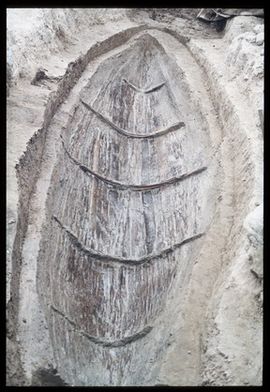The expanded boat - an experimental archaeological boatbuilding project


The Tuna Badelunda boat was built by Hanus Jensen and Rasmus Budde Jensen.The original boat was found in Sweden and dates to the middle of the 9th century - in other words, the Viking Age.
Viking Age boats were not all like the famous, clinker built longships.
The boat was originally built of pine and its height was increased with the addition of an extra plank sewn on to each side.
The frames are made of juniper.
The pine tree was 55cm in diameter, at chest height. The tree was found in Tisvilde Hegn and was one of the largest in the forest.



Hanus makes a 1:5 model of the Tuna Badelunda boat. When building the boat, the boatbuilders have tried to work out the ratios that were used on the original boat, when the Viking Age boatbuilders felled the tree and made an expanded boat.
These ratios are essential in order to produce a boat with the required form, using a suitably sized log.
The boat is also built in half-scale. The model gives a good impression of how the wood will behave in terms of being warmed up over flames and expanded.
The bark is removed from the pine log before it is hewn into shape.



Boatbuilders Raffaello Bartolini and Rasmus Budde Jensen hollow out the pine log. The boat almost has the correct dimensions.
An axe is used to shape the inner sides and edges.



Raffaello uses an adze to hew the curved internal sides. All three of the boat finds had a characteristic smoothly-planed surface.
This is a copy of a plane from the Iron Age. The boatbuilders gauge the thickness of the boat's sides by hand.



After being submerged for a while, the pine has absorbed as much water as it can. It is now ready to be expanded. Notice how the sides of the boat lean inwards across the middle of the boat. The fire is allowed to burn down until only the embers remain. The boat is then set up on blocks, close to the embers.
The boat is gradually expanded as it is warmed up. Boatbuilder Petter Mellberg uses internal bracers to expand the sides of the boat.



The heat is so extreme that the boat begins to burn, even though it is 20cm above the coals. The boatbuilders regularly throw water over the boat to control this (with a 'copy' of a 9th century floor mop...).
Hanus checks the boat's lines - it's almost the right shape.
After 45 minutes of heating and expanding, the Tuna boat has the correct shape.
Several small cracks appeared during the expansion, one of which had already been present from the start. They are repaired using a small lath, which is sewn in place, a solution that was also seen on the 9th century boat.
The lath is sewn on using spruce roots, as on the original boat.